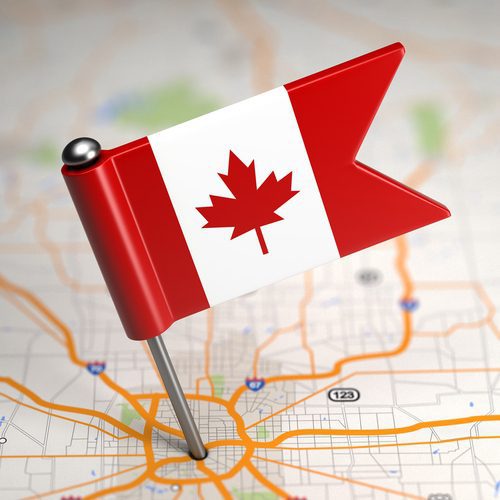Due to its close proximity to the U.S., Canada is a natural choice for retailers looking to begin their international expansion journey.
Over the past year, Canada has shown its profit potential. In 2014, e-Commerce sales in the country topped off at $22.9 billion and are expected to rise 16.8% in 2015, according to eMarketer.
“If done properly, expansion into Canada continues to be a smart growth move for U.S. retailers,” said Joel Alden, a partner in the retail practice of A.T. Kearney. “Canadian consumers have many similarities to U.S. consumers, making the learning curve steeper than going to a very different market.”
Advertisement
The profile of the Canadian shopper is relatively similar to the American shopper, noted Michael DeSimone, CEO of Borderfree. “English-speaking, high Internet and mobile phone-usage, and fans of the same everyday products — which makes it easier for retailers to connect with consumers.”
Close proximity to the U.S. also means more Canadian consumers are familiar and even follow American brands, making it easier for businesses to build relationships and generate buzz before they even open a store in the country.
Finally, from a logistics perspective, Alden said, “it’s possible to supply from existing supply chain assets in the U.S. in the short term.”
Keeping these benefits in mind makes Target’s failure to expand successfully in Canada even more puzzling, and has many industry players wondering: What went wrong?
Target: A Canadian Conundrum
After opening 133 stores across Canada, Target announced that it would be closing all area stores and would be taking a $5.4 billion write-down because of costs associated with the Canadian business.
New reports indicate that in addition to the 17,600 employee layoffs, Target has let go 550 headquarters employees as part of its exit.
The key to successfully expanding in Canada is to thoroughly understand area competition, according to Ali Asaria, CEO of Tulip Retail. Specifically retailers should ask: Why should Canadians shop with us versus our competitors? What do we offer that our competitors do not? Is there a gap in the market that we can fill?
“The responses to these questions lead us to better understand why Canadian expansion wasn’t wise for Target Canada,” Asaria said. “The company doomed itself from the start by the way it approached the market and attempting to fill the same role in Canada as it does in the U.S.”
Retailers also need to consider the preferences and buying behaviors of Canadian consumers. They “tend to be deal hunters and sensitive to price gaps with the U.S.,” Alden noted. But at the same time, retailers need to remember that because Canada is a large country with low population density, supply chain operations will be “more expansive and less responsive.”
As a result of its aggressive expansion plan, Target struggled to keep products on its shelves and speed up its supply chain operations. Couple that with Walmart waging a price war on Target in an effort to maintain area market share.
Expansion Success Stories
Despite Target’s failed expansion shaking up the industry, a myriad of other retailers have successfully expanded into Canada:
- Lowe’s Canada plans to open 25 new stores across the country over the next three years, and plans to hire up to 2,000 seasonal employees at its 37 existing stores, as well as three planned stores and a regional distribution center.
- Walmart also recently revealed that it will spend $270 million on an aggressive expansion across Canada. The Wall Street Journal reported that the retail behemoth will build 29 new supercenters and focus on expanding its distribution network.
- In January 2014, fast-fashion dynamo Uniqlo announced its first foray into Canada. The apparel retailer plans to open two flagship stores in Toronto during the fall of 2016. Given this long timeline, Uniqlo USA and Canada CEO Larry Meyer said the expansion would be approached “surgically.”
“Whenever you go into new country, you want to make sure everything’s right,” Meyer said in an interview with Fortune. “You want to understand what works and what the customer wants.”
- Whole Foods Market also is taking a strategic approach to Canadian expansion. The retailer plans to add three new locations in Greater Victoria, British Columbia; Edmonton, Alberta; and Calgary, Alberta, over the next few years.
Currently, Whole Foods operates four stores across British Columbia, and is building locations in North Burnaby and North Vancouver. The stores will open in the summers of 2015 and 2017, respectively.
Retailers should “go slow, but not too slow,” according to Alden. “Learn quickly with limited entrance, but take it seriously with a robust plan to scale.”
Final Tips For Success
As retailers continue to weigh the pros and cons of international expansion, there are several things they should keep in mind, especially as they look north of the U.S. border.
Below are final tips and best practices from industry experts:
- Do your homework: “Understand the consumer specifics with regard to your brand; the IT and supply chain investments required; and the real estate requirements and availability,” Alden said.
- Develop a leadership team: “Manage locally,” Alden advised. “It’s necessary to have leadership in country with the agility to respond to consumer dynamics and competitive actions.”
- Find your niche: “Retailers cannot rely on their reputations or ways of doing business in other countries to drive them to succeed in Canada,” Asaria said. “They must find their niche beforehand in the Canadian market and respect consumers. Agility and a test-and-learn culture are key attributes for the next generation of retail and how to succeed when expanding into Canada.”
- Localize the e-Commerce experience: “Retailers must create an online shopping experience that is tailored to the Canadian consumer,” DeSimone said. “At a basic level, this means prices should be shown in Canadian dollars, only products that are shippable to the country should be displayed, and accurate duties/taxes and shipping charges are an absolute must. Duty-free promotions entice Canadian shoppers, as well.”
- Make omnichannel a priority: “For brands that have brick-and-mortar locations, it’s important to have uniform pricing online and in-store, and purchases made online should be returnable in-store,” DeSimone said. “The most important takeaway is to focus on who the consumer is and meet his or her needs.”









